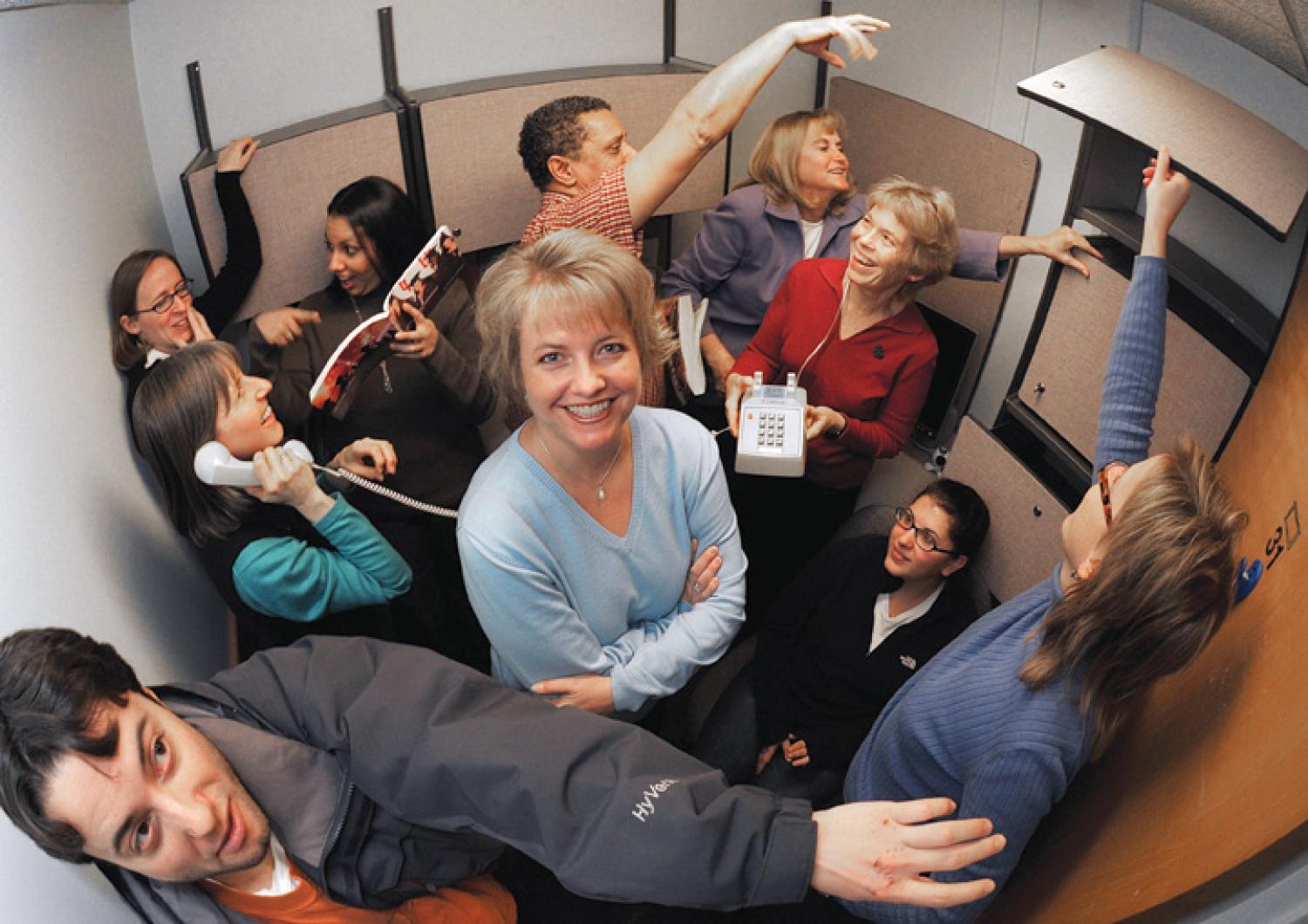
Center for Community Leads Building Boom

Career Services director Lisa Severy stands among her staff and a student in the middle of a crowded cubicle. She looks forward to their move to the Center for Community in late summer 2010.
Young students of the class of 2014 will arrive to see a campus transformed from the one students experience today.
CU-Boulder is in the throes of the largest building boom since the 1950s and early ’60s, when enrollment approximately doubled. Eight buildings and major renovation projects are already under way or will break ground between March and the end of 2009.
Undoubtedly the most significant of these buildings for students will be the Center for Community. While placing a large dining hall in the same building as the majority of student services may seem obvious, Phil Simpson, the facilities management planner for the building, says CU polled other universities around the country and found that no such building exists.
The Center fits into the concept of developing residential colleges, part of the university’s Flagship 2030 strategic plan, and a move away from traditional residential culture at CU.
“After your first year, it’s ‘let’s get out of the dorm,’ ” Simpson says. “But students will come back to this building. It’s going to draw students all year long.”
This artist’s rendering of the Center for Community shows the courtyard in front of the grand southeastern entrance that will be used by students living in Kittredge to access dining options, as well as student services.
Student services moving into the Center for Community upon its completion in 2010 include counseling and psychological services; Career Services; international education; disability services with an office on the ground floor; victim assistance; ombuds; precollegiate development; gay, lesbian, bisexual, transgender resource center; multicultural affairs; housing and dining and the Buff One Card office. In addition, an advocacy center has been funded for the third floor. It will bring ethnic student groups together to share their cultural heritage.
There are several impacts of this office shuffle. First, those moving into the Center for Community will get bright new offices, increased visibility and in some cases more space. Career Services, which has been in the basement of Willard since 1975, will go from 7,056 square feet to 7,355.
“We’re just thrilled,” says director Lisa Severy. “Most exciting for us is not more space, but the quality . . . the basement of an old dorm is not where we want to showcase our students to the employers who will hire them.”
Other campus buildings to come:
|
In addition, more space will be freed up in the dorms where student services are departing. Dormitory rooms are needed not only for the rising tide of freshmen enrollees (the campus will grow to 36,000 students by 2030, according to the Flagship 2030 strategic plan) but for upper-class students interested in joining the residential colleges being carved out of these and other dorms. Remodeling will create living space at Willard for at least 230 more students, bringing the total to 426 and for 136 additional students in Hallett Hall.
Renovating dorms for upper-class students means taking into account their unique desires and designing more apartment-style quarters, including single rooms, living rooms and separate study rooms (but still no kitchens). Classrooms, meeting rooms and tutorial cubicles in the dorms will be a part of residential colleges.
Dining Services, meanwhile, is gearing up for a major new and innovative operation at the Center for Community, including small dining rooms for classes, a display cooking station and nine constantly changing food stations serving everything from pizza to Persian food, making it “like a little Tuscan village or a ‘marche’ or market place,” says Kambiz Khalili, interim executive director of housing and dining, who says even the size of the tables and how they are spaced is being considered.
The building was conceived as a way to centralize dining services, discontinue the ongoing plan of renovating existing dining halls inside dorms and to save money. Dining halls in Farrand and Libby were renovated in the last few years, but those in Cheyenne Arapaho and Kittredge will be closed in favor of the new dining hall. “We can’t provide an attractive food program in the old dorms — it’s too costly,” Simpson says.
The dining area in the Center for Community will seat about 900 people, but size is not really part of the innovation planned for it.
“Cheyenne Arapaho’s dining hall has 13-14 square feet per table, making it too loud to hear your conversation. We want to get closer to the ideal of 25 square feet to allow for more space between tables. We want to establish an intimate space for community.”
“There will even be a grotto-like pizza place for late-night dining,” Khalili says.
With plazas on the east and west sides, one where food will be grown in the summer, wide clerestory window wells and a grand staircase, the planners are trying to create a sense of serendipity in which users walk into the building and discover something unexpected.
Other projects also will revolutionize life on campus. The 24-hour Norlin Library Information Commons, the first phase of its five-phase Renaissance project, and the renovation of several Kittredge Residence Halls are also under way or planned. Arnett, the first renovated dorm to be LEED-certified, was completed earlier this year and Andrews is in progress.
And in the final planning stages is a Regent Drive pedestrian underpass near Fiske Planetarium to be built in summer 2009, an improvement appreciated by anyone who has braved the difficult Regent Drive crossing.

